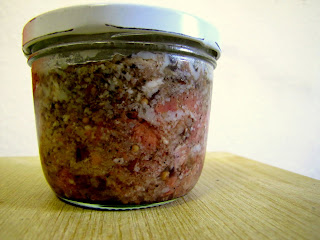
Late last night, shortly after I retired from my studies, a ravenous hunger befell me. I busted into my secret stash of hog snouts and congealed bone protein, spreading it's insanely textured contents over thin slices of gouda, and a heaping of sweet bavarian mustard. As I ate, I reflected on my evolving perceptions of German food, and even the very nature of meats themselves.
Earlier that day, a good friend of mine looked on in disgust as I showed her this new jar of artisan organic pork I had purchased. "Someone needs to reel you in Dustin!" she exclaimed, referring to my increased willingness to venture deep into the dark ocean of exotic processed meats.
Indeed, 2 months ago, I would have been the first to agree with my friend. Before I left the states, I could frequently be heard ignorantly deriding German meats as "strange organs turned into grey mush" - and I'll admit - one would be hard-pressed to argue that this description doesn't offer an accurate physical portrayal of many of the "sausages" I've experimented with lately. Accurate, perhaps, but missing the point entirely.
In the USA, many of us are conditioned from birth to view processed meat, especially those meats in cans or jars, with a great deal of skepticism and bias. We conjure up hideous images of production processes, and adopt often erroneous measures of judgement in deciding which processed meat items we will consume (e.g. hot dogs). Making matters worse for the lowly canned meats, are the imprudent levels of additives and preservatives in nearly all commercially available products.
After much research into the matter, I have discovered several brands of regionally to nationally produced artisan-quality organic canned pork and beef here in Witzenhausen. These shiny little jars offer incredible nutrition, flavour, culture, and ecology - all for an unbeatbly low price (...more on how this can be true in a future post).
The discriminant use of organ meats, blended with traditional whole-muscle cuts, provides a foundation of meat processing that truly offers a final homage to the livestock we, as a society, raise. Just as Native Americans utilized all of the buffalo as a sacred sign of respect - so too the perpetuation of these delicious old-world recipes opens an amazingly diverse way to connect with the food we eat at a much deeper level.
If we conceptualize meat as a blank canvas for artisan butchers to craft their masterpiece upon, this family of cooked sausages, or kochwurst, is the equivalent of finding a chest of forgotten paintings by Da Vinci in your grandfathers attic. We need to dust these beauties off and take a second look - perhaps for the first time...
And for those who are still not sold on taking a wild trip to the land of canned meats, don't worry - I am still working on traditional, fresh, grillable sausages....they're important too :)

I agree.
ReplyDeleteI for one found this a bit more palatable and yummy.
But I'm from the land of the highest consumption of SPAM!Haha.
That sounds delicious, you just inspired me to go look for these products in Belgium. Growing up i used to love the foods made of organs, but ever since i moved 'west' i've had a hard time finding any that inspire some degree of confidence... good to know that there are still folks around that do it the right way. Thanks man, keep up the good work!
ReplyDelete